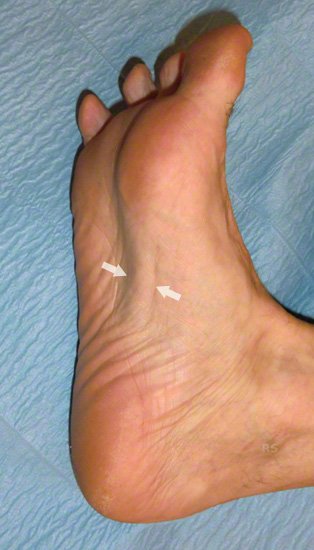Ledderhose disease is a plantar fibromatosis.
Image: You can see an approx. 2 cm wide cord formation of the so-called plantar fascia in Ledderhose disease. In this patient, however, the focus is on Dupuytren’s disease of the hand with significant curvature of the fingers.
He does not report any complaints on the foot, so there is no need for treatment. In the event of incipient pressure complaints, a special shoe insole could initially be made to relieve the pressure.
Ledderhose disease – a plantar fibromatosis
Like Dupuytren’s disease, Ledderhose disease is a fibromatosis. This means that it also leads to the formation of nodules and strands that can be assigned to a solid fiber structure (plantar fascia) of the sole of the foot. Microscopically, the tissue changes in Ledderhose disease are similar to those of Dupuytren’s disease.
While finger involvement is common in Dupuytren’s disease, the toes are extremely rarely affected in Ledderhose disease. The cords are usually found in the non-weight-bearing regions.
Ledderhose disease often occurs together with Dupuytren’s disease, but is much rarer. Approximately (depending on the literature) 1.5-10% of people with Dupuytren’s disease also have Ledderhose disease.
Complaints of Ledderhose disease
The strands and the lumps that form can cause pain when walking due to pressure, especially with hard insoles. Even with relatively harmless-looking findings, longer walking distances can be difficult.
Conservative treatment
Conservative treatment essentially consists of reducing the symptoms by means of orthopaedic insoles.
To date, there is no scientific evidence for the effectiveness of the following conservative measures in Ledderhose treatment: injection of anti-inflammatory medication, cryotherapy, laser therapy, shock wave therapy.
Irradiation
In selected cases, radiotherapy is a treatment option for Ledderhose disease without surgery. However, the possible side effects and in particular the late damage, which can occur years later, should not be concealed. These are similar to those described for Dupuytren’s disease: Radiation.
Operation for Ledderhose disease
The basic strategy of the operation is similar to Dupuytren’s surgery. The aim is to remove the altered tissue in order to achieve freedom from relapse for as long as possible.
The difference, however, is that usually no toes need to be straightened. Postoperative treatment is more difficult, however, as the foot must not bear weight for a longer period of time. Depending on the extent of the operation, you may have to walk with crutches for a few weeks.
The first describer was Gerdy
Ledderhose and Madelung are often cited as the first to describe plantar fibromatosis. However, Gerdy mentioned fibromatosis of the sole of the foot as early as 1844.
Sources
- Dupuytren’s disease: A surgical therapy concept – Brenner, Ghazi, Rayan, Millesi – Springer – Vienna 2003
- Green’s Operative Handsurgery – Green, Hotchkiss, Pederson, Wolfe – Elsevier Churchill Livingstone – Fifth Edition 2005
Pubmed
- Plantar fibromatosis – Zgonis T, Jolly GP, Polyzois V, Kanuck DM, Stamatis ED. – Clin Podiatr Med Surg. 2005 Jan;22(1):11-8. review.
- Ledderhose ‘s disease. Report of 7 cases [Article in French] – Dartoy C, Le Nen D, Riot O, Lefevre C, Courtois B. – Service de Chirurgie Orthopédique, CHU Morvan, Brest. – J Chir (Paris). 1990 Nov;127(11):533-6.
- Ledderhose disease: an unusual presentation. – Fausto de Souza D, Micaelo L, Cuzzi T, Ramos-E-Silva M. – J Clin Aesthet Dermatol. 2010 Sep;3(9):45-7.
- Irradiation in the early stages of Ledderhose disease: Radiation therapy for early stages of morbus Ledderhose – Heyd R, Dorn AP, Herkströter M, Rödel C, Müller-Schimpfle M, Fraunholz I. – Strahlenther Onkol. 2010 Jan;186(1):24-9. Epub 2009 Dec 28.


